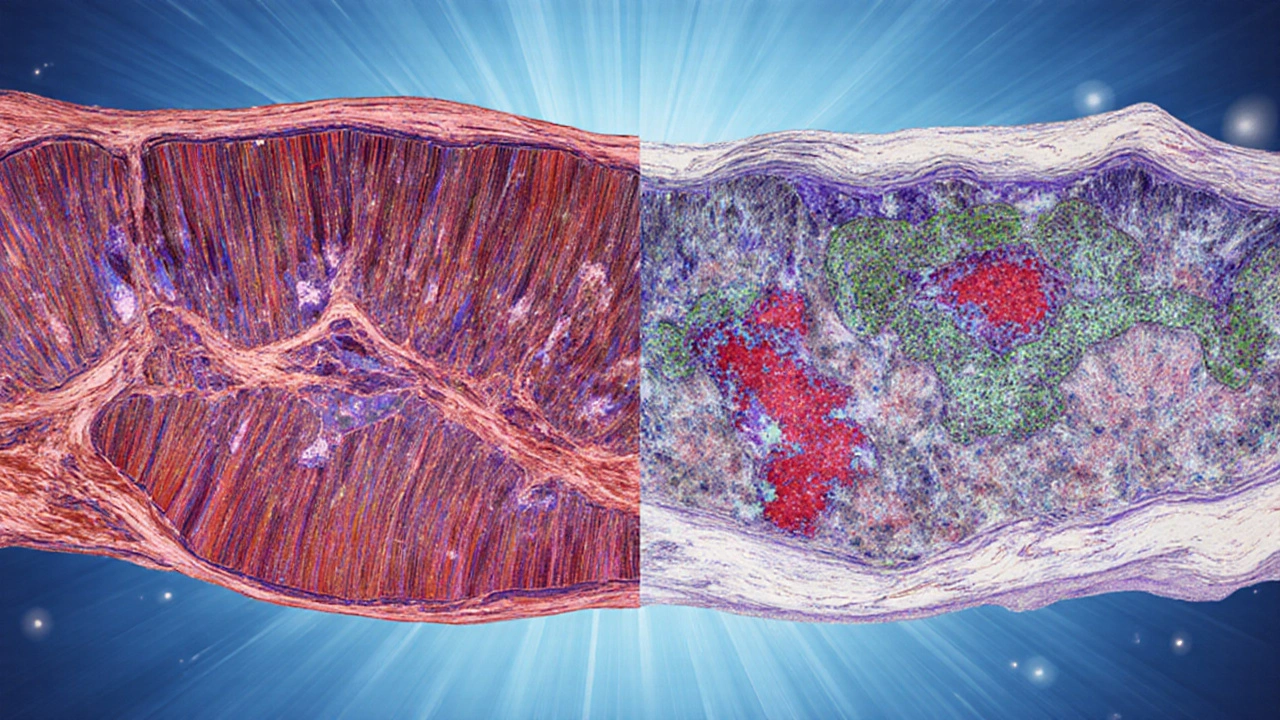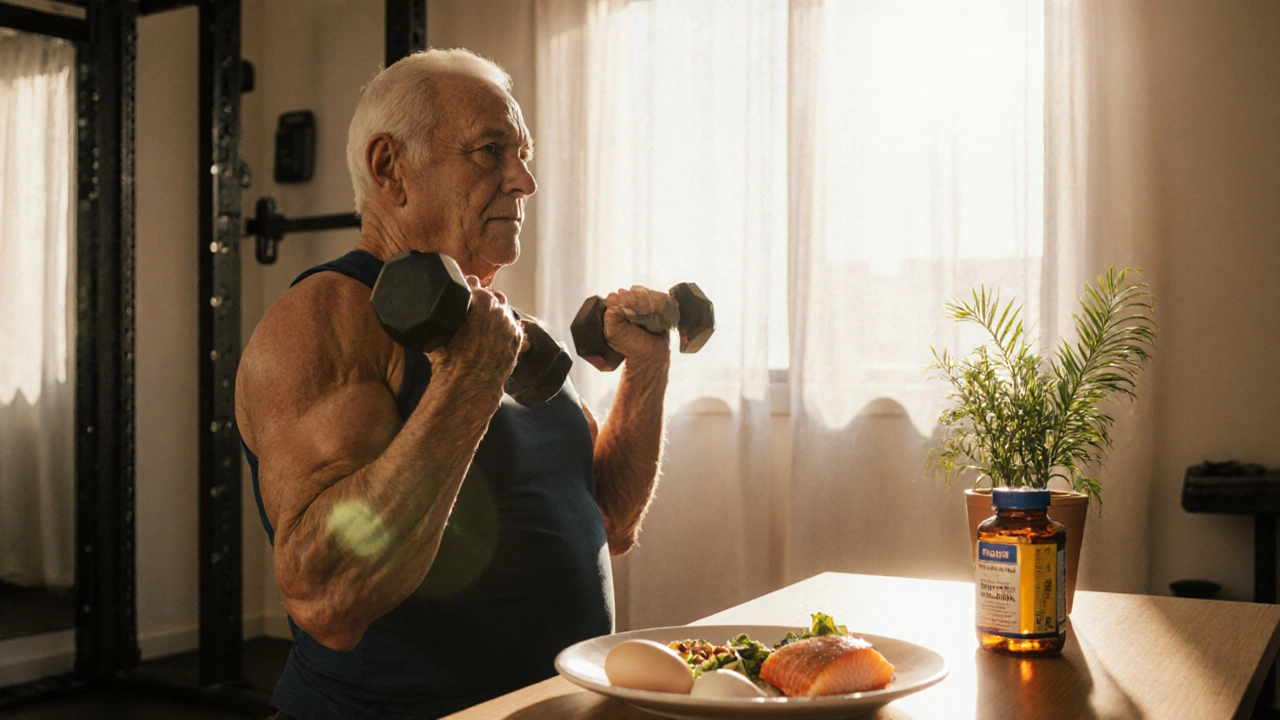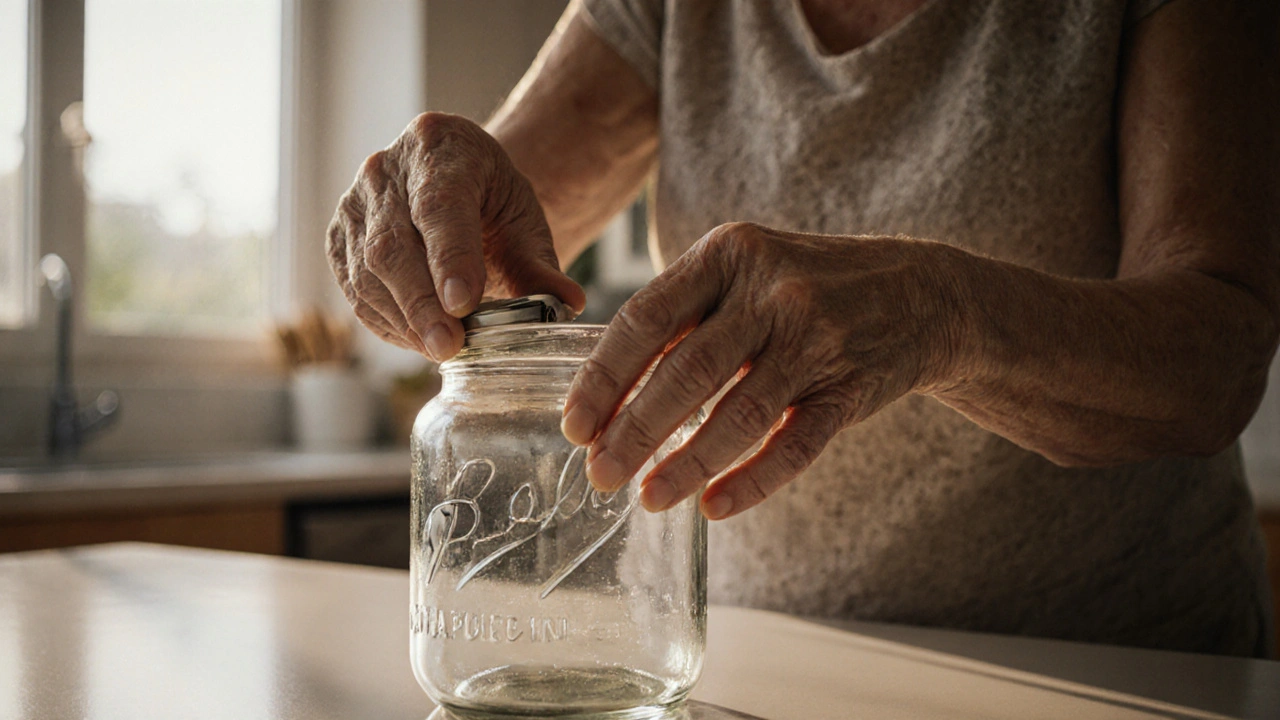Muscle Health Age Calculator
Your Muscle Health Assessment
Enter your details and click calculate to see your muscle health score.
Recommendations Based on Your Score
Results will appear after calculation.
Ever wonder why everyday tasks feel harder after you hit 60? The culprit is often a gradual decline in muscle quality and quantity, a process known as aging muscle. Understanding how age reshapes the skeletal system can help you or your loved ones stay strong, mobile, and independent.
What Makes Up Skeletal Muscle?
Skeletal muscle is a type of voluntary striated tissue responsible for movement, posture, and metabolism. It is organized into bundles called fascicles, which contain individual muscle fibers (myocytes) packed with contractile proteins actin and myosin.
Each fiber is surrounded by a thin layer of connective tissue (endomysium) and a capillary network delivering oxygen and nutrients. The whole muscle is anchored to bone via tendons, allowing force to be transmitted into movement.
Enter Sarcopenia: The Age‑Related Muscle Decline
Sarcopenia is a clinical syndrome characterized by loss of muscle mass, strength, and function that occurs with advancing age. The European Working Group on Sarcopenia in Older People defines it by a combination of low muscle quantity (usually measured by DXA or MRI) and low muscle performance (hand‑grip strength or gait speed).
Research shows that after the age of 30, muscle mass drops about 3-5% per decade, and after 60 the rate can double. By 80, many people have lost up to 30% of their original muscle tissue.

Cellular Changes Behind the Scenes
Several microscopic shifts drive the macroscopic weakness you feel.
- Muscle fibers shift from fast‑twitch (typeII) to slower, more fatigue‑resistant fibers, reducing power output.
- Satellite cells, the resident stem cells that repair and grow fibers, decrease in number and proliferative capacity, making regeneration sluggish.
- Mitochondria become less efficient, producing less ATP and more reactive oxygen species, which further damage cellular components.
- Neuromuscular junctions lose synaptic density, leading to slower signal transmission and occasional “muscle twitches.”
- Hormonal milieu shifts: testosterone, growth hormone, and insulin‑like growth factor‑1 all decline, lowering protein synthesis rates.
- Chronic low‑grade inflammation (often called “inflammaging”) releases cytokines like IL‑6 and TNF‑α that blunt muscle‑building pathways.
Functional Consequences You Can Feel
Loss of muscle isn’t just about looking thinner. It translates into real‑world challenges:
- Reduced grip strength → difficulty opening jars or carrying groceries.
- Slower gait speed → higher risk of falls; studies link a gait speed below 0.8m/s with a 3‑fold increase in mortality.
- Decreased metabolic rate → fat gain and insulin resistance, contributing to type2 diabetes.
- Impaired balance and posture → more frequent trips on stairs or uneven surfaces.
These outcomes compound, making independence harder to maintain as you age.
Proven Strategies to Counteract Muscle Loss
Good news: the aging process is not irreversible. Evidence‑based interventions can slow, stop, or even reverse sarcopenia.
- Resistance training: Engaging muscles against external loads (free weights, machines, resistance bands) stimulates protein synthesis. The American College of Sports Medicine recommends at least 2sessions per week, each comprising 2-4 sets of 8-12 repetitions for major muscle groups.
- Optimized protein intake: Older adults need roughly 1.2-1.5g/kg body weight daily, higher than the 0.8g/kg for younger adults. Distribute protein (≈30g) across meals to maximize muscle protein accretion.
- Leucine‑rich foods: Whey protein, dairy, soy, and legumes provide the essential amino acid leucine, a key trigger for the mTOR pathway that drives muscle growth.
- Vitamin D: Deficiency is linked to poorer muscle function. Aim for serum 25(OH)D levels of 30-50ng/mL, usually achieved with 800-2000IU/day supplementation.
- Anti‑inflammatory diet: Foods rich in omega‑3 fatty acids (salmon, walnuts) and polyphenols (berries, green tea) can blunt chronic inflammation, supporting recovery.
- Hormone optimisation: In select cases, clinicians may consider testosterone replacement or GH secretagogues, but only after thorough risk‑benefit assessment.
Combining these approaches yields the best results-think of a “muscle health toolkit” rather than a single magic bullet.

Quick Checklist for Older Adults
- Schedule a strength‑training session at least twice a week (e.g., body‑weight squats, dumbbell rows).
- Track protein intake; aim for 30g per meal.
- Get a vitaminD blood test; supplement if below 30ng/mL.
- Include fatty fish or a fish‑oil capsule 3 times a week.
- Monitor weight and waist circumference; unexpected loss may signal muscle wasting.
- Talk to a physiotherapist about balance exercises (e.g., single‑leg stance, tai chi).
Side‑by‑Side: Young vs. Older Muscle
| Attribute | Young Adults (20‑30 yr) | Older Adults (70+ yr) |
|---|---|---|
| Muscle mass (kg) | ≈30% higher | −30% (average) |
| TypeII fiber proportion | ≈55% | ≈35% |
| Satellite cell count (per 100fibers) | ≈12 | ≈5 |
| Mitochondrial respiration (VO₂ max) | ≈45ml·kg⁻¹·min⁻¹ | ≈25ml·kg⁻¹·min⁻¹ |
| Neuromuscular junction integrity | Intact | Partial denervation |
| Inflammatory cytokines (IL‑6, pg/mL) | ≈1-2 | ≈5-7 |
The numbers paint a stark picture, but they also highlight where interventions can make a difference-especially in protein synthesis, mitochondrial health, and inflammation control.
Frequently Asked Questions
Can I reverse sarcopenia once it has started?
Yes, moderate to high‑intensity resistance training combined with adequate protein can increase muscle mass by 5‑10% even in people over 80. The key is consistency and progressive overload.
How much protein should I eat per day?
Aim for 1.2-1.5grams of protein per kilogram of body weight. For a 70‑kg individual this means roughly 84‑105g daily, split into 3-4 meals.
Is walking enough to keep my muscles healthy?
Walking improves cardiovascular health but stimulates only slow‑twitch fibers. Adding 2‑3 sessions of resistance work each week is essential for preserving strength.
Do supplements like creatine help older adults?
Research shows creatine (3-5g per day) can boost lean mass and strength when paired with training, with minimal side effects for most older adults.
Should I get hormone therapy to fight muscle loss?
Hormone therapy may help a subset of men with clinically low testosterone, but it carries cardiovascular and prostate risks. Always discuss with a qualified physician before starting.
Understanding the biology behind age‑related muscle changes empowers you to act early. By mixing smart nutrition, targeted strength work, and periodic health checks, you can keep your muscles robust well into the golden years.




Timothy Javins
October 7, 2025 AT 19:58Just because you’re older doesn’t mean you’re doomed to flabby arms.
Kay Yang
October 7, 2025 AT 21:00Interesting read, thanks for breaking down the science 🧬. I appreciate the clear checklist – makes it easier to share with my parents. The vitamin D tip is especially useful, we’ve been low on sunshine lately 🌞. Hopefully more people will start resistance workouts instead of just walking.
Rajesh Kumar Batham
October 7, 2025 AT 22:23Great summary! 💪 The part about satellite cells shrinking with age really hit home – my dad always complains his muscles don’t recover. Adding whey shakes after workouts could be a simple fix. Keep the tips coming! 😊
Michael Wall
October 7, 2025 AT 23:46We all have a duty to look after our bodies as we age. Simple things like a daily walk and a protein snack go a long way. Ignoring these signs is just selfish. Let’s be responsible.
Christopher Xompero
October 8, 2025 AT 01:10OMG THIS IS THE ULTIMATE GUIDE TO STOPPING YOUR MUSCLES FROM TURNING INTO JELLY!!! 😱 If you skip the protein you’ll literally crumble like a cookie. The article is like a lifeline, don’t you dare ignore it!!
Irene Harty
October 8, 2025 AT 02:00While the article presents a well‑structured overview, one cannot dismiss the possibility that certain pharmaceutical interests may downplay the efficacy of over‑the‑counter supplements. It would be prudent to consider independent studies before adopting any regimen.
Jason Lancer
October 8, 2025 AT 03:06I get that the article is trying to be helpful, but honestly it reads like a checklist for a corporate wellness program. First off, the protein numbers are tossed around like a magic bullet without any context about calorie intake. Then they throw in vitamin D levels as if a simple supplement will fix decades of sedentary living. Sure, resistance training is great, but expecting retirees to lift heavy dumbbells three times a week is unrealistic for most. The piece also glosses over the socioeconomic barriers that prevent many older adults from affording quality protein sources. What about people who live in food deserts and can’t even get fresh fish? And the suggestion to get a vitamin D blood test – who’s paying for that? They also ignore the fact that many seniors are on medications that interact with supplements. I’m not saying you shouldn’t move more, but the article feels preachy and out of touch. A real solution would discuss community programs, low‑cost exercises, and culturally appropriate foods. It would also acknowledge that muscle loss is a multifactorial issue, not just a lack of whey protein. The tone is overly optimistic, as if you can reverse 30% loss with a few extra eggs. In practice, it takes months of consistent effort and often professional guidance. So while the information isn’t wrong, the delivery is shallow. If you’re looking for a quick fix, you’ll be disappointed. Bottom line: read the article, then figure out what’s actually doable in your own life.
Kiersten Denton
October 8, 2025 AT 04:13Thanks for the insight, that was helpful.
Courtney Payton
October 8, 2025 AT 05:20It is quite evident that neglecting muscular health leads to a cascade of frailty, yet society often overlooks this inevitably fate. We must encourage disciplined habits, lest we succumb to decay.
Muthukumaran Ramalingam
October 8, 2025 AT 06:26Bro, I feel ya – skipping gym makes you feel older fast. Guys in my area just do simple push‑ups on the balcony, no fancy gear. Eats cheap beans + rice for protein, works for us. Keep it real, man.